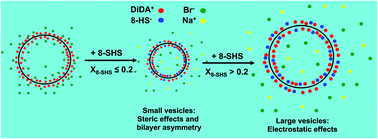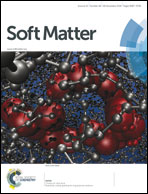Characterization and stability of catanionic vesicles formed by pseudo-tetraalkyl surfactant mixtures†
Abstract
The phase behavior of an ad hoc synthesized surfactant, sodium 8-hexadecylsulfate (8-SHS), and its mixtures with didecyldimethylammonium bromide (DiDAB) in water is reported. We dealt with dilute concentration regimes, at a total surfactant content of <30 mmol kg−1 where vesicular aggregates may be formed. The high synergistic behavior of such catanionic mixtures is concomitant with strongly negative interaction parameters, β (≈−18 kBT), significant gain in the free energy of association, ΔGagg, and much lower association concentration compared to the pure surfactants. Vesicle size and ζ-potential depend on the mixture composition. Hydrodynamic diameters increase by progressive addition of oppositely charged surfactants to the one in excess. Counter-intuitively, the ζ-potential becomes more negative at DiDAB molar fractions close to 0.2. The same holds in the reverse case, the ζ-potential becomes more positive after small additions of 8-SHS; anyhow, the effect is more significant in anionic-rich mixtures. This phenomenon was explained by assuming a significant release of counterions and an asymmetric distribution of the two surfactants in the inner and outer vesicle leaflets. The equimolar mixtures form a cubic phase rather than the expected lamellar one. The effect of NaBr concentration on the stability of catanionic vesicles was also investigated. At high NaBr concentrations, all systems are destabilized. For DiDAB-rich vesicles, flocculation is observed, while for 8-SHS-rich ones, lamellar domains are formed at the bottom of the samples. The role played by NaBr depends on whether it is added before or after mixing the surfactants. In particular, preformed catanionic vesicles show a great kinetic stability towards addition of NaBr compared to those obtained by other procedures.


 Please wait while we load your content...
Please wait while we load your content...